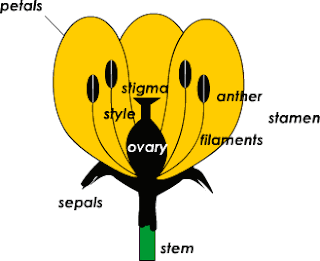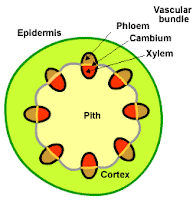Assessment Statement 9.3: Reproduction in angiospermophytes
9.3.1 Draw and label a diagram showing the structure of a dicotyledonous animal = pollinated flower.
9.3.1 Draw and label a diagram showing the structure of a dicotyledonous animal = pollinated flower.
9.3.3 Draw and label a diagram showing the external and internal structure of a named dicotyledonous seed.

9.3.4 Explain the conditions needed for the germination of a typical seed.
Seeds require a combination of :
oxygen for aerobic respiration
water to metabolically activate the cells
temperature for optimal function of enzymes
for their successful germination. Each seed has its own particular combination of the above three factors.
It maybe that in a particular species these processes need to be proceeded by other more specialised conditions such as:
fire
freezing
passing through digestive system of a seed dispersing animal
washing to remove inhibitors (beans)
erosion of the seed coat (Poppy)
The particular conditions required by a seed allows it to match germination to favourable conditions
9.3.5 Outline the metabolic processes during germination of a starchy seed.
Absorption of water precedes the formation
of gibberellin in the embryo’s cotyledon. This
stimulates the production of amylase, which
catalyses the breakdown of starch to maltose. This
subsequently diffuses to the embryo for energy
release and growth..
9.3.6 Explain how flowering is controlled in long-day and short-day plants, including the role of phytochrome.
Flowering Cues:
Plant have to coordinate the production of flowers to coincide with the best reproductive opportunities. There are many environmental cues that affect flowering however the photoperiod is the most reliable indicator on 'time' of year.
The photoperiod the period of day light in relation to dark (night). In northerly and southern regions this photoperiod is a reliable indication of the time of year and therefore one of the most reliable indicators of the seasonal changes.
Short and Long day Plants:
Short day plants (SDP) typically flower in the spring or autumn when the length of day is short.
Long day plants (LDP) typically flower during the summer months of longer photoperiod.
Critical Night Length:
Experiments have shown that the important factor determining flowering is the length of night rather than the length of day. Therefore it may help students to remember
SDP have a critical long night. That the length of night has to exceed a particular length before there will be flowering.
LDP have a critical short night. That the length of night must be shorter than a critical length before there will be flowering.
e.g. Cocklebur is an SDP with a critical night length of 9 hours, when flowering will occur. A shorter night does not produce flowering.
(It is worth noting that this is not the only combination of environmental triggers that bring about flowering. )
Phytochrome System:
The receptor of photoperiod is located within the leaf.
The cellular location of the receptor is unclear.
The chemical nature of the receptor is a the molecule PHYTOCHROME.
Phytochrome can be converted from one form to another by different types of light.
Flowering in SDP:
Short day plants flower when the night period is long.
In day light or red light, Phytochrome Red (Pr) is converted to Phytochrome Far Red (Pfr). The conversion actually only requires a brief exposure to white or red light.
In the dark, Pfr is slowly converted back to Pr. A long night means that there is a long time for the conversion.
Under short day conditions (long night) at the end of the night period the concentration of Pfr is low.
In SDP, low Pfr concentration is the trigger for flowering.
Flowering in LDP:
Long day plants flower when the night period is short.
In day light (white or red) the Pr is converted to Pfr.
During periods when the day light period is long but critically the dark period is short, Pfr does not have long to breakdown in the dark. Consequently there remains a higher concentration of Pfr.
In LDP, high Pfr concentration is the trigger to flowering.
The mechanism of flowering:
The search for the substance that causes the development of meristematic tissue into flowers was focused on the identification of 'florigen', the flowering hormone.
Phytochrome Fr is the biologically active form of phytochrome but it is florigen. Most research indicates that phytochrome cannot move from the leaf cells to the meristem tissue.
In 2005 a substance, mRNA (FL mRNA) was finally isolated that was found to be moving from leaf to flower meristem.
This mRNA provides a link between the phytochrome system (the receptor), its activation of genes in the leaf (mRNA synthesis) and the differentiation of the meristem into the flower structure
http://click4biology.info
Plant have to coordinate the production of flowers to coincide with the best reproductive opportunities. There are many environmental cues that affect flowering however the photoperiod is the most reliable indicator on 'time' of year.
The photoperiod the period of day light in relation to dark (night). In northerly and southern regions this photoperiod is a reliable indication of the time of year and therefore one of the most reliable indicators of the seasonal changes.
Short and Long day Plants:
Short day plants (SDP) typically flower in the spring or autumn when the length of day is short.
Long day plants (LDP) typically flower during the summer months of longer photoperiod.
Critical Night Length:
Experiments have shown that the important factor determining flowering is the length of night rather than the length of day. Therefore it may help students to remember
SDP have a critical long night. That the length of night has to exceed a particular length before there will be flowering.
LDP have a critical short night. That the length of night must be shorter than a critical length before there will be flowering.
e.g. Cocklebur is an SDP with a critical night length of 9 hours, when flowering will occur. A shorter night does not produce flowering.
(It is worth noting that this is not the only combination of environmental triggers that bring about flowering. )
Phytochrome System:
The receptor of photoperiod is located within the leaf.
The cellular location of the receptor is unclear.
The chemical nature of the receptor is a the molecule PHYTOCHROME.
Phytochrome can be converted from one form to another by different types of light.
Flowering in SDP:
Short day plants flower when the night period is long.
In day light or red light, Phytochrome Red (Pr) is converted to Phytochrome Far Red (Pfr). The conversion actually only requires a brief exposure to white or red light.
In the dark, Pfr is slowly converted back to Pr. A long night means that there is a long time for the conversion.
Under short day conditions (long night) at the end of the night period the concentration of Pfr is low.
In SDP, low Pfr concentration is the trigger for flowering.
Flowering in LDP:
Long day plants flower when the night period is short.
In day light (white or red) the Pr is converted to Pfr.
During periods when the day light period is long but critically the dark period is short, Pfr does not have long to breakdown in the dark. Consequently there remains a higher concentration of Pfr.
In LDP, high Pfr concentration is the trigger to flowering.
The mechanism of flowering:
The search for the substance that causes the development of meristematic tissue into flowers was focused on the identification of 'florigen', the flowering hormone.
Phytochrome Fr is the biologically active form of phytochrome but it is florigen. Most research indicates that phytochrome cannot move from the leaf cells to the meristem tissue.
In 2005 a substance, mRNA (FL mRNA) was finally isolated that was found to be moving from leaf to flower meristem.
This mRNA provides a link between the phytochrome system (the receptor), its activation of genes in the leaf (mRNA synthesis) and the differentiation of the meristem into the flower structure
http://click4biology.info



Comments
Post a Comment